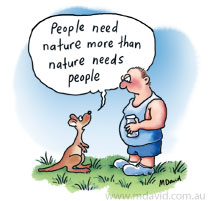
I used to think human politics were complicated. Then I started learning about bird politics. Now, I should really say I’m talking about bird behaviour here because the word “politics” has too many connotations of kissing babies in exchange for votes. And I’ve never seen a bird stoop that low. Yet birds have lives rich in complex interactions with other creatures.
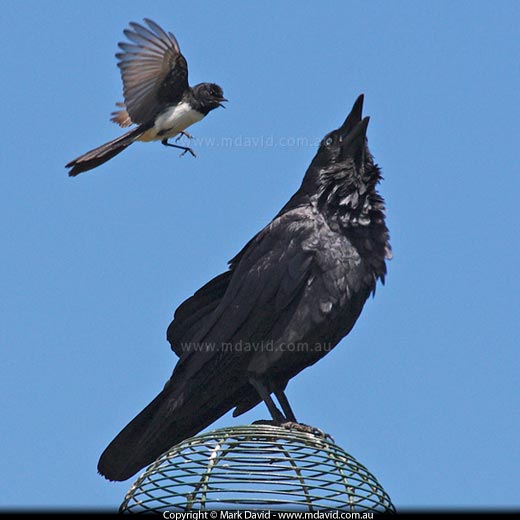
Ruffled feathers: A Willie Wagtail (Rhipidura leucophrys) harassing an Australian Raven (Corvus coronoides)
Lots of bird politics are structured around their needs. And when you think about it, birds’ needs are pretty much the same as ours. They need food, air and water, shelter, security, a chance to breed and an iPad. Okay, some human bias found its way into that list but birds need mental stimulation too, especially some of the smarter ones like cockatoos. To put things bluntly, if birds couldn’t meet those needs then we wouldn’t have birds.
Schoolyard bullies
In Eastern Australia there’s a common indigenous bird called the Noisy Miner (Manorina melanocephala). These guys don’t need much of an introduction to anyone living with them around because they can make themselves known by being notoriously territorial and aggressive. Noisy Miners are greedy nectar eaters and if there’s a good source of it nearby, perhaps a Banksia with lots of flowers, then they’ll want it all to themselves. So they carry on like schoolyard bullies, chasing away any other bird that tries to approach.
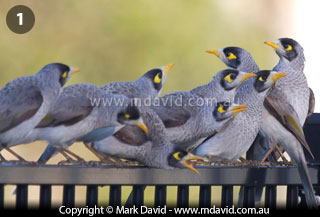
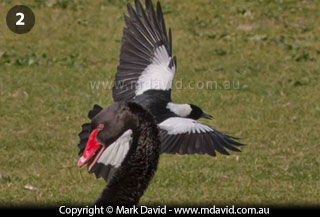
1: War cabinet — a group of Noisy Miners (Manorina melanocephala) assembles briefly on a fence. Moments after this shot was taken they took off in pursuit of a pair of Magpies. 2: Australian Magpie swooping a Black Swan.
Noisy Miners are closely related to another bully bird called the Bell Miner (Manorina melanophrys). Bell Miners, sometimes called Bellbirds, are known for causing patches of Eucalyptus forests to get sick. They do this by taking over large stands of trees and driving away all the other birds that would have helped to control insect parasites.
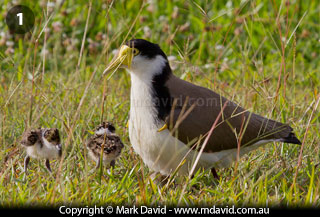
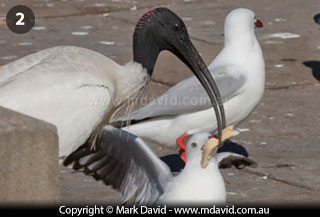
1: Masked Lapwing with an egg and two newly-hatched chicks 2: Bird brawl — An Australian White Ibis (Threskiornis molucca) and a Silver Gull (Larus novaehollandiae) play tug-of-war over a scrap of bread.
There’s one particular type of insect at the centre of this story. Stuck to the leaves of those gum trees are things called lerps. Lerps are tiny sugary secretions made by even tinier sap-sucking insects called psyllids. The psyllids hide inside the lerps while they feed on the leaves. Birds such as pardalotes love to eat the lerps, which helps the trees’ defence against the parasite. But the greedy Bell Miners want a forest full of lerps and their insect occupants all to themselves.
Border security

Unwelcome — A Noisy Friarbird (Philemon corniculatus) chases a Torresian Crow (Corvus orru) out of the area.
Defence of territory is common among other kinds of birds too. One species taking its territorial boundaries seriously is the Australian Magpie (Gymnorhina tibicen). They form themselves into groups with a dominant male in charge, and mentally stake out their patch of turf, not so much against other species but against other groups of Magpies. It’s fun watching when one Magpie group wanders into the boundary of another — you just know things are about to get crazy. When this happens, the biggest group has a real advantage. They take off and swoop and chase their rivals using the kinds of speed and aerobatics that would make a fighter pilot proud. When one group has driven its opponents away its members will take to the nearest high perch and burst into exuberant song, called carolling. It’s a beautiful sound.
The famous call of the Laughing Kookaburra (Dacelo novaeguineae) is another example of a high-spirited claim of territory. A pair of birds will find a high perch and make their call to establish the immediate area as their own.
Family politics
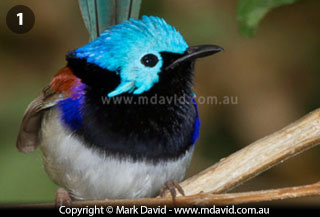
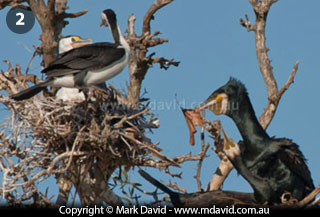
1: Dressed to impress — A male Variegated Fairy-wren (Malurus lamberti) puts on a magnificent display when he’s decked out in his breeding plumage 2: Branch stacking — Some birds are happy to nest alongside other birds or even other species. This photo shows a pair of Pied Cormorants (Phalacrocorax varius) above a pair of Great Cormorants (Phalacrocorax carbo).
Masked Lapwing (Vanellus miles novaehollandiae) chicks spend at least the first six weeks of their life on the ground. There’s no shortage of threats during those flightless early days, including snakes, raptors and dogs. Thankfully, the chicks are born knowing how to follow instructions from their parents.
The parent birds spend a lot of their time guiding the young from place to place, using a series of different calls. The chicks know their place in the family structure and follow their parents’ guidance obediently. And then a year later, parental devotion turns to aggression when mum and dad chase the young away to make space for another brood.
War
Sometimes politics doesn’t work and war breaks out. I’ve seen this happen a lot in places where people feed wild birds. Throwing large amounts of food into a gathering of birds changes the dynamics of the group. Where the biggest meal previously went to the smartest or most diligent bird, it suddenly becomes the reward for the fastest or most aggressive individuals. Birds which are normally placid will turn on their own species or others. This can be stressful for all the avian participants, yet is strangely calming for the people throwing the food.
Sexual politics
The courtship rituals of birds are so varied and complex that you wouldn’t even try to cover them all in a single article. So let’s just say that breeding behaviour takes on a whole new level of complexity.
Some birds, like the male Variegated Fairy-wrens (Malurus lamberti), dazzle their prospective partners with displays of colourful plumage. It’s commonly assumed that all the males are brightly coloured but it’s only the breeding males that put on that display. The colourful plumage probably shows that the male is strong and healthy — the kind of things the females might well be looking for.
Losing their tempers
If you ever thought birds didn’t have tempers, then maybe you haven’t been reprimanded up close by a Willie Wagtail (Rhipidura leucophrys). Birds get angry at each other too.
Most displays of bird anger don’t lead to much. For example, when rival male Black Swans (Cygnus atratus) approach each other on a pond they’ll often arch their necks, puff out their feathers and circle each other in a display of size and strength. Only occasionally does this escalate into pecking and flapping their wings at each other.
However there’s one thing that’s almost bound to make birds angry, and that is a threat to their young. Predator birds like raptors and crows sometimes feed on young chicks and so when they enter a nesting area used by other birds it’s common to see several different species of smaller birds working together to chase the predator away from their area. Other birds like Masked Lapwings are famous for swooping at anything that comes close to their chicks.
Teamwork
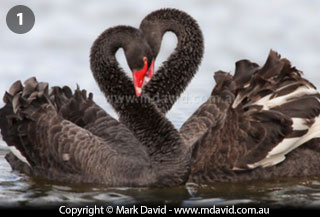
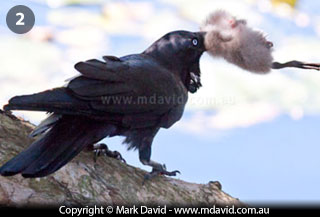
1: Love and war — The necks of these two Black Swans (Cygnus atratus) might resemble the shape of a love heart, but this display is more an example of posturing between rivals. 2: Predator — An Australian Raven (Corvus coronoides) about to fly away with a young chick stolen from some other birds.
It’s not just chasing away potential predators that shows us birds working together. Australian Pelicans (Pelecanus conspicillatus) work in groups to steer fish towards shallow water where the fish are easier to catch. Little Black Cormorants (Phalacrocorax sulcirostris) will also work in teams, diving underwater together to round up fish. Other types of birds will also share the task of raising chicks among a large group. The Superb Fairy-wren (Malurus cyaneus) is one example.
Social life
Some of the more intelligent birds like Lorikeets and Cockatoos live in large groups. Stand next to the ear-splitting racket made by several hundred Rainbow Lorikeets (Trichoglossus haematodus) in their night-time roosting trees and you’ll be witnessing a whole lot of bird politics. Expect to see birds preening each other, chasing, posturing, competing for the best perches, and forming bonds — or in other words, carrying on like politicians.
You could fill a whole library of books about avian interactions. This article has only touched on a few ways that they interact with themselves and other creatures. So next time you’re embroiled in some office politics, remember that it might not be all that different if you were a bird.
